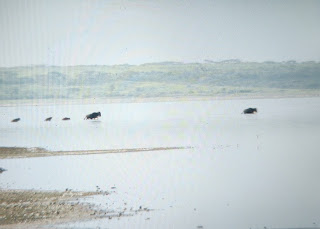The entire reason we came to the south Seringiti was to see the migration of the Wildebeest. These animals migrate constantly following the rainfall patterns. By March some 2.5 million will be in this area where they give birth and then teach their young how to survive the trip to the north. There were many , many wildebeest around but only a tiny fraction of the number which will be here at the migration's peek.
In this part of the Ngorogoro Reserve there is a lake whiich the wildebeest use to teach the young. It is about the right width and is about 5 feet deep in the middle and there are no crocs.
Unfortunately the water is very alkaline which is dangerous as when the animals cross it their scent is washed away. As they use scent to identify each other, the babies, who often get separated from their mothers cannot find them again and vice versa. In fact even if they find each other they cannot recognize each other without having the scent present. The baby's are then very vulnerable to predators or die of natural causes like getting stuck in mud and drowning.
Even with these dangers, the wildebeest will, after reaching the safety of the shore, turn and do it again and again.
Although this is sad indeed, it offers a food source to other animals who also need to eat to survive.
I






No comments:
Post a Comment